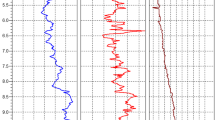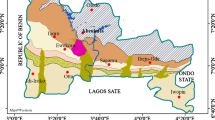Abstract
Over the past decade, direct-push geotechnical sensors or penetration probes have earned widespread acceptance in the geoenvironmental fields of study as a more viable and cost-effective solution for the assessment of soil and groundwater contamination. Of these, resistance cone penetrometer (RCPT) devices equipped with electrical sensors have been successful in qualitatively locating contaminated areas. While the RCPT method has proved to be successful for delineating inorganic contaminants in the saturated zone, its applicability in the vadose zone and soils contaminated by hydrocarbon compounds have been doubtful. The objective of this research is therefore focused on verifying the applicability of capacitance measurements on an existing RCPT module to provide information on the moisture content and presence of various kinds of contaminants. Laboratory experiments were performed on carefully prepared soil layers to investigate the sensitivity of the measured capacitance on the soil moisture content and different types of contaminants. Results confirmed that the measured capacitance of soils reflected the volumetric amount of water present in both un-contaminated and contaminated soils. In addition, capacitance measurement showed potentials for applicability in detecting plumes of non-aqueous phase contaminants above the groundwater table. Consequently, recommendations were made on the basis to which capacitance measurements can support interpretations of the electrical resistivity data.
Similar content being viewed by others
References
ASTM D3441-86 Standard test method for deep, quasi-static, cone, and friction-cone penetration tests of soil.
Bell, J., Dean T.J. and Hodnett M.G., 1987, Soil moisture measurement by an improved capacitance technique, Part II. Field techniques, evaluation and calibration. Journal of Hydrology, 93, 79–90.
Campanella, R.G. and Weemees, I., 1990, Development and use of an electrical resistivity cone for groundwater contamination studies. Canadian Geotechnical Journal, 27, 557–567.
Dean, T.J., Bell J.P. and Baty, A.J.B., 1987, Soil moisture measurement by an improved capacitance technique, Part I. Sensor design and performance. Journal of Hydrology, 93, 67–78.
Fukue, M., Minato, T., Matsumoto, M., Horibe, H. and Taya, N., 2001, Use of a resistivity cone for detecting contaminated soil layers. Engineering Geology, 60, 361–369.
Kaya, A., 2002, Evaluation of soil porosity using a low MHz range dielectric constant. Turkish Journal of Engineering and Environmental Sciences, 26, 301–307.
Kaya, A. and Fang, H.Y., 1997, Identification of contaminated soils by dielectric constant and electrical conductivity. Journal of Environmental Engineering, ASCE, 123(2), 169–177.
Morabito, P., Lanciani, I. and Benoit, J., 1998, Electrical resistivity cone penetration (ERCPTU) testing at the Treasure island national geotechnical experimention site in San Francisco, California. NSF Report. 25 p.
Oh, M.H., 2005, Development of detection system for subsurface contamination based on the electrical properties of soil. Ph.D. thesis, Seoul National University, Seoul, Korea, 198 p.
Pyo, H.S., Park, S.J., Park, S.S., Hong, J.E. and Lee, K.J., 1998, A study of analytical methods for oils in contaminated soil. Journal of Korea Soil Environment Society, 3(2), 3–12 (in Korean with English Abstract).
Rinaldi, V.A. and Redolfi, E.R., 1996, The dielectric constant of soil-NAPL mixtures at low frequencies (100 Hz–10 MHz), Proceeding of Nonaqueous Phase Liquids (NAPLs) in the Subsurface Environment: Assessment and Remediation. ASCE, Washington D.C., 163–174.
Rowe, R.K., Shang, J.Q. and Xie, Y., 2001, Complex permittivity measurement system for detecting soil contamination. Canadian Geotechnical Journal, 39, 498–506.
Santamarina, J.C. and Fam, M., 1997, Dietectric permittivity of soils mixed with organic and inorganic fluids (0.2 GHz to 1.30 GHz). Journal of Environmental and Engineering Geophysics, 2(1), 37–51.
Santamarina, J.C., Klein K.A. and Fam, M.A., 2001, Soils and waves. John Wiley & Sons, West Sussex, England, 488 p.
Van Nostrand, R.G. and Cook, K.L., 1966, Interpretation of resistivity data. U.S. Geological Survey, Professional Paper 499, USGS, Washington D.C.
Weemees, I., 1990, Development of a resistivity cone for groundwater contamination studies. M.A. Sc. Thesis, University of British Columbia, Vancouver, B. C., Canada.
Author information
Authors and Affiliations
Corresponding author
Rights and permissions
About this article
Cite this article
Kim, Y.S., Oh, M.H. & Park, J. Laboratory study on the dielectric properties of contaminated soil using CPT deployed probe. Geosci J 11, 121–130 (2007). https://doi.org/10.1007/BF02913925
Received:
Accepted:
Issue Date:
DOI: https://doi.org/10.1007/BF02913925




